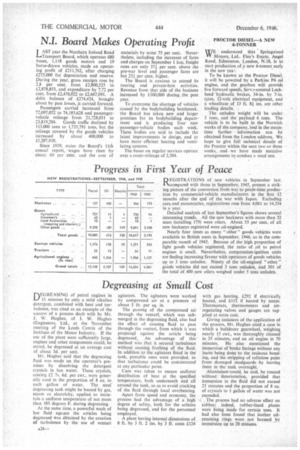Degreasing at Small Cost D EC;REASING of petrol engines in 15
Page 28

If you've noticed an error in this article please click here to report it so we can fix it.
minutes by only a mild alkaline detergent, combined with heat and turbulence, was cited as an example of the success of a process dealt with by Mr. J. W. Hughes, of J. W. Hughes (Engineers), Ltd., at the November meeting of the Leeds Centre of the institute of the Motor Industry. If the use of the plant were sufficiently large, engines and other components could, he stated, be degreased at an average cost of about 3d. per unit.
Mr. Hughes said that the degreasing fluid was made on the operator's premises by dissolving the detergent crystals in hot water. These crystals, costing /2 7s. 6d. per cwt., were generally used in the proportion of 8 oz. to, each gallon of water. The steel degreasing tank might be heated by gas. steam or electricity, applied to maintain a uniform temperature of not more than 185 degrees F. during degreasing.
At the same time, a powerful wash of hot fluid against the articles being degreased was obtained by the creation of turbulence by the use of venturi
agitators. The agitators were worked by compressed air at a pressure of about 5 lb. per sq. in.
The passing of the compressed air through the venturi, which was submerged in the degreasing fluid, also had the effect of causing fluid to pass through the venturi, from which it was projected against the article being degreased.. An advantage of this' method was that it secured turbulence without causing frothing of the fluid. In addition to the agitators fitted in the tank, portable ones were provided, so that turbulence could be concentrated' at any particular point.
Care was taken to ensure uniform distribution of heat at the specified temperature, both underneath and all around the tank, so as to avoid cracking of the fluid through local overheating.
Apart from speed and economy, the process had the advantage of a high degree of safety, both for the articles being degreased, and for the personnel employed.
A plant having internal dimensions of 6-ft. by 3 ft. 2 ins. by 3 ft. costs £124
with gas heating, £292 if electrically heated, and £152 if heated by steam. Thermostats, thermometers and airregulating valves and gauges are supplied at extra cost.
Giving instances of the application of the process, Mr. Hughes cited a case in which a bulldozer gearwheel, weighing nearly 15 cwt., was thoroughly cleaned in 35 minutes, and an oil engine in 70 minutes. He. also mentioned the immersion of brake facings without any harm being done to the resinous bonding, and the stripping of cellulose paint from damaged mudguards' by leaving them in the tank overnight.
Aluminium'could, he said, be treated without deterioration, provided that immersion in the fluid did not exceed 25 minutes and the proportion of 8 oz. of crystals to I gallon of water was not exceeded.
The process had no adverse effect on rubber; indeed, rubber-lined plants were being made for certain uses. It had also been found that leather oilretaining rings were not harmed by inunersiOn up to 20 minutes.




































































